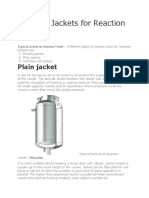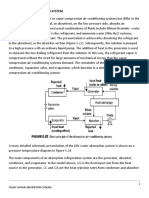Conventional Jackets
Conventional Jackets
Uploaded by
kayeCopyright:
Available Formats
Conventional Jackets
Conventional Jackets
Uploaded by
kayeOriginal Description:
Original Title
Copyright
Available Formats
Share this document
Did you find this document useful?
Is this content inappropriate?
Copyright:
Available Formats
Conventional Jackets
Conventional Jackets
Uploaded by
kayeCopyright:
Available Formats
Conventional Jackets
Figure 1: Conventional
Jacket
"Conventional jackets" can be divided into two (2) main categories: baffled and non-baffled.
Baffled jackets often utilize what is known as a spirally wound baffle. The baffle consist of a
metal strip wound around the inner vessel wall from the jacket utility inlet to the utility outlet.
The baffle directs the flow in a spiral path with a fluid velocity of 1-4 ft/s. The fabrication
methods does allow for small internal leakage or bypass around the baffle. Generally, bypass
flows can exceed 1/3 to 1/2 of the total circulating flow.
Conventional baffled jackets are usually applied with small vessels using high temperatures
where the internal pressure in more than twice the jacket pressure.
Spirally baffled jackets are limited to a pressure of 100 psig because vessel wall thickness
becomes large and the heat transfer is greatly reduced. In the case of an alloy reactor, a very
costly vessel can result. For high temperature applications, the thermal expansion differential
must be considered when choosing materials for the vessel and jacket. Design and construction
details are given in Division 1 of the ASME Code, Section VIII, Appendix IX, "Jacketed Vessel".
Heat Transfer Coefficients: Conventional Jackets without Baffles
(hj De / k) = 1.02 (NRe) 0.45 (NPr) 0.33 (De/ L) 0.4 (Djo/ Dji) 0.8 (NGr) 0.05 Eq. (1)
Figure 2: Schematic of Conventional
Jacket
Where:
hj = Local heat transfer coefficient on the jacket side
De = Equivalent hydraulic diameter
NRe = Reynolds Number
NPr = Prandtl Number
L = Length of jacket passage
Djo = Outer diameter of jacket
Dji = Inner diameter of jacket
NGr = Graetz number
The Reynolds Number is defined as:
NRe = DVρ/μ
Where D is the equivalent diameter, V is the fluid velocity, ρ is the fluid density, μ and is the
fluid viscosity.
The Prandtl Number is defined as:
NPr = Cp μ / k
Where Cp is the specific heat, μ is the viscosity, and k is the thermal conducitivity of the fluid.
The Graetz Number is defined as:
NGr = (m Cp) / (k L)
Where m is the mass flow rate, Cp is the specific heat, k is the thermal conducitivity, and L is the
jacket passage length.
The equivalent diameter is defined as follows:
De = Djo-Dji for laminar flow
De = ((Djo)2 - (Dji)2)/Dji for turbulent flow
Conventional Jackets with Baffles
For conventional jackets with baffles, the following can be used to calculate the heat transfer
coefficient:
hj De/k= 0.027(NRe)0.8 (NPr)0.33 (µ/µw)0.14 (1+3.5 (De/Dc) ) ( For NRe > 10,000) Eq. (2)
hj De/k = 1.86 [ (NRe) (NPr) (Dc/De) ] 0.33 (µ/µw)0.14 ( For NRe < 2100 ) Eq. (3)
Figure 3: Schematic of Conventional Jacket
with Baffle
Two new variables are introduced. Dc is defined as the centerline diameter of the jacket passage.
It is calculated as Dji + ((Djo-Dji)/2). The viscosity at the jacket wall is now defined as µw. When
calculating the heat transfer cofficients, an effective mass flow rate should be taken as 0.60 x
feed mass flow rate to account for the substantial bypassing that will be expected. De is defined
at 4 x jacket spacing. The flow cross sectional area is defined as the baffle pitch x jacket spacing.
You might also like
- Calculate Outside Heat Transfr Coeff. For JacketDocument6 pagesCalculate Outside Heat Transfr Coeff. For JacketSuryakant RanderiNo ratings yet
- Design and Fabrication of Screw ConveyorDocument2 pagesDesign and Fabrication of Screw ConveyorAhmad JobNo ratings yet
- Agitated Vessel Heat TransferDocument7 pagesAgitated Vessel Heat TransferalokbdasNo ratings yet
- Agitators For Standard Tanks: I Anchor-Type AgitatorsDocument6 pagesAgitators For Standard Tanks: I Anchor-Type AgitatorssrNo ratings yet
- Ex Reactor DesignDocument10 pagesEx Reactor DesignNugraha Weedhee ANo ratings yet
- 02 Mechanical-Design ESDocument36 pages02 Mechanical-Design ESJessica Andrea Tafur DiazNo ratings yet
- Product Catalog: Advance Glass Reactor SystemDocument10 pagesProduct Catalog: Advance Glass Reactor SystemRafique AjmeriNo ratings yet
- MixerDocument10 pagesMixerKRYSTEL WENDY LAHOMNo ratings yet
- Heat Transfer in Jacketed VesselsDocument5 pagesHeat Transfer in Jacketed VesselsSalman ZafarNo ratings yet
- 5560 English PDFDocument11 pages5560 English PDFdonya100% (1)
- Impeller PerformanceAug17 FRDocument10 pagesImpeller PerformanceAug17 FRSteve WanNo ratings yet
- B-901 Mixer Impellers LTN 12Document5 pagesB-901 Mixer Impellers LTN 12Abidin RahmanNo ratings yet
- Chapter Five Equipment Design 5.1 Design of Vertical Ribbon MixerDocument12 pagesChapter Five Equipment Design 5.1 Design of Vertical Ribbon MixerHamza Al MahanaNo ratings yet
- Prediction of HETP For Randomly Packed Towers Operation:integration of Aqueous and Non-Aqueous Mass Transfercharacteristics Into One Consistent CorrelationDocument18 pagesPrediction of HETP For Randomly Packed Towers Operation:integration of Aqueous and Non-Aqueous Mass Transfercharacteristics Into One Consistent Correlationcamilo_ortiz_6No ratings yet
- (How To) Select A Motor Capacity For Agitator - Pharma EngineeringDocument9 pages(How To) Select A Motor Capacity For Agitator - Pharma EngineeringpratikNo ratings yet
- Problem Example of Pneumatic Conveying SystemDocument9 pagesProblem Example of Pneumatic Conveying SystemSh.nasirpur100% (1)
- Reactor Design Calculation 06062123Document2 pagesReactor Design Calculation 06062123projectliterature767835No ratings yet
- Types of Jackets For Reaction VesselDocument4 pagesTypes of Jackets For Reaction VesselPRATHU SINGHNo ratings yet
- Evaluate Filtration Feasibility in ANFDDocument3 pagesEvaluate Filtration Feasibility in ANFDpratikNo ratings yet
- Agitator Design EP v1.6Document5 pagesAgitator Design EP v1.6NAYAK87No ratings yet
- Filter PressDocument2 pagesFilter Presskamod.rai528No ratings yet
- (207 - Transfer Torque and Efficiency Analysis of Magnetic Gear - Application Catalog - Application Catalog) JMAGDocument2 pages(207 - Transfer Torque and Efficiency Analysis of Magnetic Gear - Application Catalog - Application Catalog) JMAGbnbaNo ratings yet
- L-CV-155-VA-24XX01 Nitrogen: ASME Sec VIII Div 1+ PED97/23/ECDocument1 pageL-CV-155-VA-24XX01 Nitrogen: ASME Sec VIII Div 1+ PED97/23/ECevrim77No ratings yet
- Assignment 3Document1 pageAssignment 3Abhijit KushwahaNo ratings yet
- Questionaire For Drum Flaker - NEWDocument2 pagesQuestionaire For Drum Flaker - NEWBhavin TalatiNo ratings yet
- Optimize Mixing Using The Proper BafflesDocument6 pagesOptimize Mixing Using The Proper Baffles1940LaSalle100% (1)
- Agitator Design and SpecificationsDocument6 pagesAgitator Design and SpecificationsJesseNo ratings yet
- Hydrofoil - US5297938Document8 pagesHydrofoil - US5297938rwtoorresdNo ratings yet
- Review On Design of AgitatorDocument4 pagesReview On Design of AgitatorAnonymous YWS7ndsiNo ratings yet
- Data Book Process Equipment DesignDocument36 pagesData Book Process Equipment DesignDevil King100% (2)
- 3 Date 2 1 0 R e V I S I o N Checked by Checked by Approve DbyDocument2 pages3 Date 2 1 0 R e V I S I o N Checked by Checked by Approve DbyidilfitriNo ratings yet
- Tank EductorDocument3 pagesTank Eductorkonainglincho001No ratings yet
- Belt Filter Press TBEDocument2 pagesBelt Filter Press TBEmayukhguha1988No ratings yet
- Science Raking in Gravity Thickeners PDFDocument17 pagesScience Raking in Gravity Thickeners PDFJuan Alberto Giglio FernándezNo ratings yet
- Agitator DesignDocument3 pagesAgitator DesignSmrutiNo ratings yet
- Magnetkupplungen, Rührwerksantriebe Für Chemische Reaktoren: BMD Und Cyclone: Absolut Dicht, Sicher Und ZuverlässigDocument8 pagesMagnetkupplungen, Rührwerksantriebe Für Chemische Reaktoren: BMD Und Cyclone: Absolut Dicht, Sicher Und ZuverlässigJohn HaasNo ratings yet
- Hydrofoil Agitator 1Document8 pagesHydrofoil Agitator 1Production AdvisorNo ratings yet
- Volute Design ReviewDocument4 pagesVolute Design ReviewMohammed El-ShahatNo ratings yet
- Design and Development of Solar Dryer For Chilli Drying: February 2014Document17 pagesDesign and Development of Solar Dryer For Chilli Drying: February 2014Zulhambri ZulNo ratings yet
- Tubesheet As Per ASME Sec. VIII-Div.1 UHXDocument1 pageTubesheet As Per ASME Sec. VIII-Div.1 UHXruponline1No ratings yet
- Cyclonexls PDF FreeDocument22 pagesCyclonexls PDF FreeAdri YasperNo ratings yet
- Tank Baffles Design CalcDocument8 pagesTank Baffles Design Calchamid vahedil larijani0% (1)
- Equation-Loss Calc Large DuctsDocument2 pagesEquation-Loss Calc Large Ductskumar123rajuNo ratings yet
- Agitator - Technical CatalougeDocument12 pagesAgitator - Technical CatalougesaurabhNo ratings yet
- Screw Conveyor Excel CalculationDocument8 pagesScrew Conveyor Excel Calculationhardik033No ratings yet
- Agitator Power Requirement and Mixing Intensity CalculationDocument29 pagesAgitator Power Requirement and Mixing Intensity CalculationHimatush0% (1)
- Brochure SuperSettlerDocument8 pagesBrochure SuperSettlerJesús RiberaNo ratings yet
- Hydrofoil - US5951162Document22 pagesHydrofoil - US5951162rwtoorresd100% (1)
- Design of Boiler Forced Draft FanDocument2 pagesDesign of Boiler Forced Draft FanAu TagolimotNo ratings yet
- Design of Shell & Tube HXDocument62 pagesDesign of Shell & Tube HXUmirahRashidahNo ratings yet
- Electrostatic Precipitator (ESP)Document20 pagesElectrostatic Precipitator (ESP)avmurugan87No ratings yet
- PV Wet ScrubberDocument7 pagesPV Wet ScrubberCepi Sindang Kamulan100% (1)
- Design of AgitatorDocument6 pagesDesign of AgitatorVishalNo ratings yet
- Pede Proj 1Document28 pagesPede Proj 1Jibril hassen kedirNo ratings yet
- Conventional JacketsDocument4 pagesConventional JacketsTerence TanNo ratings yet
- Jacketed Vessel DesignDocument9 pagesJacketed Vessel DesignSyed HaideriNo ratings yet
- Jacketed Vessel DesignDocument5 pagesJacketed Vessel DesignfunkkkkyNo ratings yet
- Jacketed Vessel DesignDocument5 pagesJacketed Vessel Designfunkkkky100% (2)
- Dimple Jacket Heat Transfer EstimationDocument3 pagesDimple Jacket Heat Transfer EstimationicingrockNo ratings yet
- Tank Dimensions Liquid Level Liq. Level To Dia. Ratio Typical Mixer Budget PriceDocument6 pagesTank Dimensions Liquid Level Liq. Level To Dia. Ratio Typical Mixer Budget PriceeleyaysieyM.No ratings yet
- Feasibility Study - Design of An Industrial Park With Low Energy Concumption PDFDocument53 pagesFeasibility Study - Design of An Industrial Park With Low Energy Concumption PDFkaye100% (1)
- Media 228repDocument2 pagesMedia 228repkayeNo ratings yet
- Lecture - 5 Neutron Life CycleDocument18 pagesLecture - 5 Neutron Life CyclekayeNo ratings yet
- Lecture - 7 Fick's LawDocument11 pagesLecture - 7 Fick's LawkayeNo ratings yet
- Lecture - 8 Steady State Diffusion EquationDocument16 pagesLecture - 8 Steady State Diffusion EquationkayeNo ratings yet
- Lecture - 4 Controlled FissionDocument12 pagesLecture - 4 Controlled Fissionkaye100% (1)
- Lecture - 9 Two-Group Neutron DiffusionDocument12 pagesLecture - 9 Two-Group Neutron DiffusionkayeNo ratings yet
- Asia's Nuclear Energy GrowthDocument5 pagesAsia's Nuclear Energy GrowthkayeNo ratings yet
- Energy Balances and CO2 ImplicationsDocument6 pagesEnergy Balances and CO2 ImplicationskayeNo ratings yet
- II.3.1 Microscopic Cross SectionsDocument4 pagesII.3.1 Microscopic Cross SectionskayeNo ratings yet
- Noble Metal AlloysDocument77 pagesNoble Metal AlloysVivek Choukse50% (2)
- Physical-Science-Module 4 The Development of The Atomic StructureDocument23 pagesPhysical-Science-Module 4 The Development of The Atomic StructureJoana CastilloNo ratings yet
- Science - Adh1853 SMDocument44 pagesScience - Adh1853 SMgetahun esubalewNo ratings yet
- Chemisty-1 UdvashDocument41 pagesChemisty-1 Udvashjustin cruiseNo ratings yet
- Therminol 66Document8 pagesTherminol 66yohaneswpNo ratings yet
- Dry Air Gas PropertiesDocument25 pagesDry Air Gas Propertiesmshah222No ratings yet
- Agregat MC-V6-ZF49K5-TFD - R449ADocument5 pagesAgregat MC-V6-ZF49K5-TFD - R449AMario UrsuNo ratings yet
- Solid State Synthesis of BaTiO3Document6 pagesSolid State Synthesis of BaTiO3MalachiSimonChuaDingcong100% (3)
- Gases: Animation 3.1: Boyle's Law Source & Credit: WikipediaDocument55 pagesGases: Animation 3.1: Boyle's Law Source & Credit: WikipediaMian MuneebNo ratings yet
- Heat Capacity Ratio: Laboratory Experiment No. 2Document25 pagesHeat Capacity Ratio: Laboratory Experiment No. 2aefNo ratings yet
- UOP Engineering Design - Fractionation PDFDocument263 pagesUOP Engineering Design - Fractionation PDFThienthan10095% (22)
- Callen Thermodynamics Solution PDFDocument2 pagesCallen Thermodynamics Solution PDFArnaldo Goncalves BragaNo ratings yet
- Practice Test 1Document8 pagesPractice Test 1Momin FayzanNo ratings yet
- Volume Expansion - Problems and SolutionsDocument8 pagesVolume Expansion - Problems and SolutionsApril Mae BaldozaNo ratings yet
- Rates of Reaction LabDocument3 pagesRates of Reaction LabHobi and Jimin’s waRM Jinger Tae with Suga KookiesNo ratings yet
- 235practice Exam 3 AnswerDocument4 pages235practice Exam 3 Answersowmmiya karuppiahNo ratings yet
- Solar Vapour Absorption SystemDocument7 pagesSolar Vapour Absorption SystemMir Aqueel AliNo ratings yet
- Solubility WorksheetDocument2 pagesSolubility Worksheetapi-263104299100% (5)
- October 2020 (IAL) QPDocument32 pagesOctober 2020 (IAL) QPlinaratennakoonNo ratings yet
- Max PlanckDocument1 pageMax Planckmr personalNo ratings yet
- Problem Set No. 2 (Drying - Humidification)Document2 pagesProblem Set No. 2 (Drying - Humidification)aizel ariolaNo ratings yet
- 2b ElectrolytesDocument3 pages2b ElectrolytesErica Alviyanti BastiandNo ratings yet
- POLARIZATIONDocument54 pagesPOLARIZATIONfunkpatel123No ratings yet
- Beta CaroteneDocument2 pagesBeta CaroteneChou ChouNo ratings yet
- MSC Syllabus CurrentDocument110 pagesMSC Syllabus CurrentRajesh YadavNo ratings yet
- Nanotechnology Fabrication MethodsDocument15 pagesNanotechnology Fabrication Methodspaula posadaNo ratings yet
- Solid-State Properties in Preformulation: Centre For Pharmaceutical SciencesDocument45 pagesSolid-State Properties in Preformulation: Centre For Pharmaceutical SciencesK SANDHYANo ratings yet
- 3.2 Use of Amount of Substance On Pure Substances QPDocument33 pages3.2 Use of Amount of Substance On Pure Substances QPjanakhalifeNo ratings yet
- June 2016 (IAL) MS - Unit 4 Edexcel Chemistry PDFDocument27 pagesJune 2016 (IAL) MS - Unit 4 Edexcel Chemistry PDFMaria KolokasiNo ratings yet
- Electrochemistry: Chemistry 30 WorksheetsDocument49 pagesElectrochemistry: Chemistry 30 Worksheetsdan anna stylesNo ratings yet



































































































